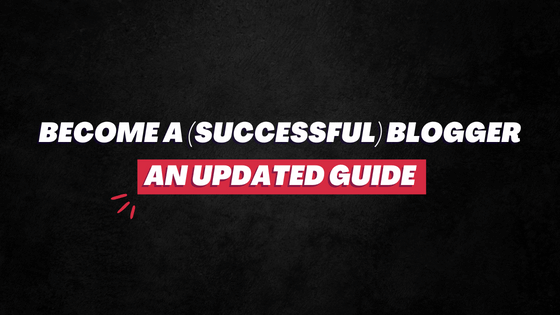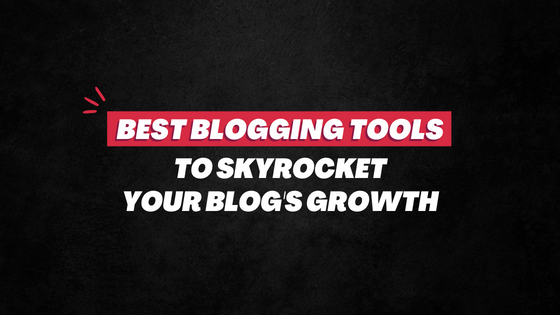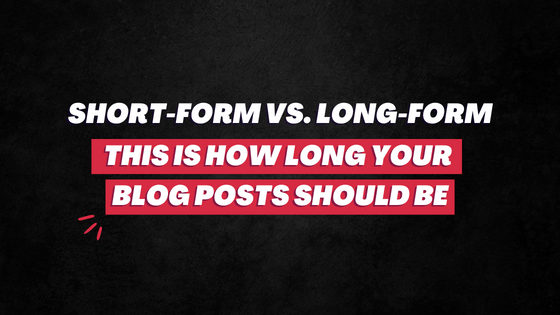Unless you want an “online diary” for yourself, there are a lot of things that need to be considered when starting a blog.
There are many elements to it that must be done correctly so to keep yourself ahead of the curve and competitors.
Besides, as opposed to a few years back, to start a blog in 2020 is a whole different affair.
No more should your domain name be packed with keywords. With search engines focusing more on User Experience (UX), your blog design must go beyond just being an eye candy.
This is a complete guide that will take you step-by-step to start a blog for free in 2020.
Btw, if you already had a blog but you stopped blogging for whatever reason and now you want to make a comeback, I have written a separate post for you. Please read: Ignored Your Blog for Months? 19 Tips to Restart the Right Way
Pat yourself on the back to have even thought of starting a blog and, hopefully, taking it seriously. 🙂
1. What to blog on?
The first thing you need to do is find out about the topic that you want to blog on.
Now as simple as it may sound, it’s also the most confusing part of this entire process. There are literally thousands of people who want to start a blog for free — but they’re confused “about what”.
A lot of things go into figuring out your blogging topic or niche. Of course, your own interest and expertise are the foremost considerations.
What are you interested in? What is that thing that you’re an expert in?
If you’re lucky, you will have the same answer for both questions. It will make things easier for you.
However, often, for many people, their interests and expertise vary. They are interested in games but are experts in accountancy. Some are interested in anthropology but their technical proficiency lies in architecture.
For these people, it’s difficult to figure out the right blogging niche for themselves.
And then when you throw the competition and money aspects in this mix, things get even more confusing.
For instance, you might be interested in collecting cards. But can that interest match your income expectation?
You’re an expert in managing a team of clerks at a bank. How can you deploy that skill to make money from blog?
These are some important questions and considerations that you should be attentive to in this very first stage.
Choosing the right topic
The fundamentals of choosing a good blogging topic lie within the boundary of five principles:
- What do you like?
- What are you good at?
- How much money can you make?
- Can you blog about it for at least 5 years without getting bored?
- Is there a market demand for that?
Answer these questions individually and carefully. Don’t rush. Take your time. You will definitely figure out a topic to blog on.
NOTE: Don’t be a victim of ‘paralysis by analysis’ though. You don’t want to spend weeks and months thinking on this.
Recommended Read: How to find the best blogging topics that make money?
2. The money prospect
Let’s not beat around it. You’re starting a blog to earn money. Period. So, don’t pull that “I want to help… * blah blah*” 😉
In this case, it’s important that you take your venture as a business — and do what every business owner does, which is to think about how will you make money, when will you break even, what kind of income you can expect, and so forth.
As mentioned earlier, when choosing the topic for your blog, you must factor in the money aspect as well.
But once you have selected a niche that will likely be profitable for you, it’s time now to dig deeper into it to uncover more concrete answers.
How profitable could it be?
First, have a clear picture of what will be your primary revenue model.
The easiest way to find that out is to look at your successful competitors. If you already know who they are, just visit their website and see what stream is making them the most money. In the initial stage, you should follow the same strategy.
In case, if you don’t know who your competitors are, a basic Google search with your primary keywords will solve this problem.
Google a relevant phrase to your industry. Like this…
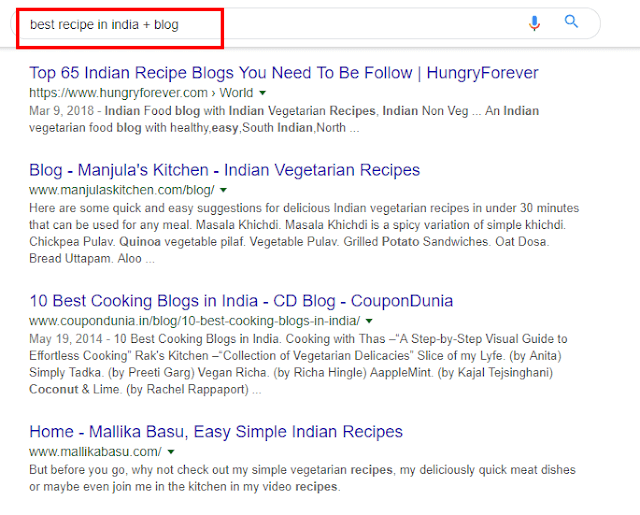
The first few results are likely your successful competitors. Enter and see what revenue model they have. And then, if it fits your goal and comfort, unhesitantly follow what they are doing.
While at it, when researching your competitors, you can also create a set of benchmarks for yourself, in terms of how much website traffic you want, what kind of social presence should you create, how many articles to write, and how much annually you can earn.
Tools like SEMrush are perfect for competitive analysis.
These benchmarks will give you a sense of direction as to where should you be heading with your blog.
3. Find a domain name
As simple as the task may look, it isn’t.
You simply cannot come up with anything that pops into your head. Your domain name is your blog name, which is also your business aka brand name. So, you’ve got to be very cautious when selecting it.
A perfect domain name is…
- Short, simple, and sensible
- Easy to remember
- Easy to pronounce
- Easy to type
- Telling about the blog/business
Now, of course, coming up with such an ideal name is a complete back-breaker. More so today than ever when every good domain name is already taken.
This is where being creative will pay you well.
Something creative and interesting
You need to stretch your horizon beyond the common phrases to come up with creative names. Like, using acronyms, adding unique suffixes/prefixes, getting rid of silent alphabets, and so forth.
Examples of some creative domain names are…
- Abof (All About Fashion)
- GetResponse
- Makr
- Goodreads
- Pick Up Limes
- Travels of Adam
There are many other such cool and creative names. You’ve got to come up with one for yourself.
There exist a handful of decent domain name generators out there. Namemesh is a popular one. You type in your key phrase and the tool will return with a list of available domain names under different heads.

However, it’s best you take only “inspiration” from such tools and not blindly follow their suggestions.
It’s YOUR blog. It’s YOUR business. It’s YOUR brand. So the domain name idea should be YOURS as well—personalized, thoughtful, and related to your vision.
Tips to choose a good domain name
Here are some basic tips to choose a good domain name:
(i) Anything more than 18 characters is a big no. 15 characters max.
(ii) Make sure you can pronounce it easily (and without spitting lol)
(iii) Avoid including numbers and characters. Also, don’t spell numbers (like sixty-five). It’s confusing.
(iv) Include a keyword. Not necessarily the whole phrase; even a single word would do.
(v) Always go with .com extension. It’s standard.
However, if it makes sense, you can certainly use other top-level extensions. (But remember, people always assume a domain ends with .com. Your audience will too. If you’re selecting something else, make sure to brand that extension with your blog name properly so that people remember.)
(vi) Make it scalable. For instance, you don’t want ‘ITalkCar(dot)com’ when there’s a possibility you will talk about bikes and gadgets in the coming future.
(vii) Is this name brandable? Ask this question. The answer is “YES” if it’s easy to pronounce, remember, write, and appreciate.
(viii) Check its meaning. You don’t want to be stuck with a domain name that means something offensive or embarrassing.
(ix) Check if any company exists with the same name. A simple Google search is adequate.
(x) Test the name with a few people. Ask friends and family for their opinions.
All being said, be careful in choosing a domain name — BUT don’t spend too much time here. The more you will think, the more confusing it gets.
Once you have finalized a name, register it. There are a handful of good domain name registrars: Namecheap, domain(dot)com, 1&1, Google Domain, and name(dot)com.
They all offer almost similar plans and offers with virtually the same add-ons. So, don’t think too much about picking the right domain registrar.
Recommended Read: 23 Practical Tips to Choose A Domain Name For Your Blog
When choosing a domain name, you must also make sure that the desired username is available on social media websites.
Of course, this isn’t essential. You can, after all, figure out an alternative and creatively-unique name for your social media username.
For instance, if your domain name is “IamJacobScott(dot)com” and that exact username isn’t available on Twitter and Insta, you can go creative with alternatives like “JacobScottHere” or “iJacobScott”.
No doubt, having the same domain name and social media usernames across all channels is more desirable. But sometime, you won’t have it this way. You’re going to have to settle for slightly different usernames on social media.
Is it available?
Now moving along, once you have settled on, and purchased, a domain name, time to capture a unique username on all major social media channels.
Use Namechk to find out if the username is available or not.
Here’s what my search for “IamJacobScott” returned with…
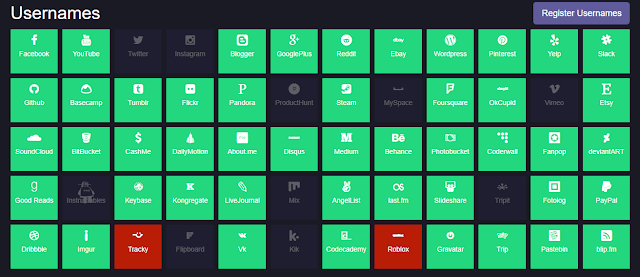
The username is available on platforms in green. For those in dark, the username is already taken there. And the ones in red, the tool has failed to reach the service.
Since “IamJacobScott” is already taken on Twitter and Instagram, I will look for some other alternative that’s available everywhere.
Once you have found the desired username, create profiles on ALL major social channels. Even when you have no plan of using them, just capture the username and leave it alone.
5. Look for a good web host
Where will you host your website? It’s an important question.
In layman’s terms, web hosting providers are companies that rent you some space in their servers to store your website files. Their server/CPU remains ‘ON’ all the time. This keeps your website live and accessible for all.
Now, there are many web hosting companies out there. Each has its own unique plans, pricing, and features. You’ve got to pick one that adequately fits your needs, requirements, and budget.
Unsurprisingly, again, finding a good web host provider isn’t a very easy task.
But to begin with, here are some popular and most preferred web hosting providers you can go with:
- Bluehost
- Hostgator
- GoDaddy
- SiteGround
- iPage
- Dreamhost
- BigRock
- Hostinger
- A2 Hosting
All these service providers, in terms of quality and reliability, are great with maximum uptime and incredible customer support.
Which is the best?
Again, which one of these is ideal for you depends on the kind of website you want to create, the storage/bandwidth you want, the budget you have, and so forth.
I personally recommend Hostgator and Bluehost. You, sure, can check others as well.
Do a side-by-side comparison of each and see who’s offering what. Cross-check their pricing and hidden charges. And then pick a web host company, and the right plan, that you think is ideal for the starters.
Before you go about picking the best web hosting provider, just remember not to overestimate your needs. You’re just beginning. You wouldn’t need so much space, bandwidth, and add-on features for the first few months. And as you see such new needs arise in the coming days, you can always upgrade your plan.
Get Started With WordPress Hosting @ just $3.95/month
6. Which CMS?
CMS is a Content Management System.
Back in the day, you would have to upload and manage a website using FTP. Today, in the web 2.0 age, you get user-friendly, intuitive, and real-time applications, called CMS, for seamless website management.
There are many good content management systems out there, including some specifically meant for bloggers.
You’ve likely heard of self-hosted WordPress.org — one of the world’s leading CMS, used by some of the top brands, from TechCrunch and Variety to Quartz and Time Inc.
There’s also WordPress(dot)com — hosted but limited in functionalities.

(Infographic Courtesy: iThemes)
And then you, of course, know about Google’s Blogger/BlogSpot as well.
Aside from these two, Joomla, Drupal, Tumblr, Wix, and Squarespace are other renowned CMS blogging platforms.
While sure you can pick any one of them, it is best you stick with either WordPress or Blogger.
Note, if you’re not good with HTML/CSS, you’re going to have problems with Blogger moving forward.
The ‘Right’ Pick
So, to keep blog management easier and more scalable for yourself, go with WordPress.org. It’s very simple to use and, above all, there’s a dedicated community who can help you whenever you’re stuck anywhere.
Besides, these days, many top web hosting companies come with dedicated WordPress hosting plans. You can sign-up for such a plan and get instant access to your cPanel without the need of ‘Quick Installing’ the latest WordPress software on your rented server.
So, in short, do all your research but, in the end, it’s best you go with WordPress.
7. Research your competitors
This is something that doesn’t usually come in the guides on how to start a blog for free. And I can see why. But by no means is it any less important.
You’re a new blogger. You’re a beginner. And even if you’re a prodigy, you will face a handful of problems. You will be confused about certain things. There will be a lot of unanswered questions in your head.
This is where doing a competitive analysis will help you.
Researching your successful competitors will help answer all your relevant questions.
Start by creating a list of a few competitors who are the top names in your industry. Google your primary keyword and the first few results are the names you’re looking for.
In addition, you can also use Alexa’s Find Similar Sites tool. Type in the URL of the most popular website in the field and the tool will return a list of similar, high-authority websites.
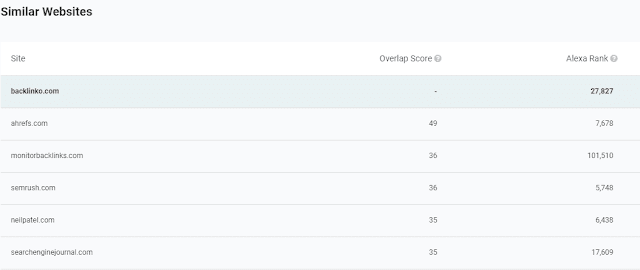
Once you have the names, do some research on them. Whatever questions you have, find answers by looking at their strategies and approach.
What to ‘research’?
For instance, see…
- The kind of website/blog design they have.
- The kind of content they are publishing — the topics, length, frequency.
- What keywords they are targeting?
- What social media platforms they are most active on?
- How they are branding themselves.
- What’s their revenue model; what’s their #1 source of income?
- The way they are scaling their business.
The more you understand them and their strategies, the clearer will it become for you as to how to become a successful blogger.
Recommended Read: How to do Keywords Research for Free in 11 minutes
8. A (Thoughtful) Blog Design
Indeed, blogging is all about content. But a lot also depends on the way you’re offering that content.
It’s like a dish — just as much about presentation as it is about taste.
Present the dish well and you can sell it at a much higher price as compared to without proper presentation. (Something that posh restaurants exploit.)
Did You Know: A visitor takes only 50 milliseconds to form an opinion about your website.
Now, fortunately, for CMSs like WordPress, there come many free and paid themes. To that, they are also easy to customize.
A tad complex part of the process, however, is selecting the right theme for your blog.
Themeforest is possibly the best place. It has thousands of themes and templates of a diverse range of CMSs, well sorted into different categories. Browse through the website and select one.
How to choose a good theme?
Although it would depend on your needs and niche, here are a few tips to choose a good theme for your blog:
- Avoid picking an image-heavy theme.
- Make sure it’s responsive.
- Stay away from homepage sliders. (Read more on Above The Fold Content Optimization)
- Say “no” to dull and boring color schemes.
- Test on mobile and see how it performs.
- Check its loading speed; ensure it’s less than 3 seconds. (Use GTmetrix)
- Ensure the navigations are easy to access and are in the right places.
- Pick a theme that you’re comfortable customizing.
There are plenty of other dos and don’ts of choosing a good theme for your blog. But for the starters, just make sure you don’t solely get carried away by its “look” but also care just as much about its performance and UX elements.
Also, don’t plan too much customization or changes for later.
Don’t go “I will change that later” “I will fix that myself”. Sure, you can — but not without spending too much time on it. And at this stage, you don’t want to spend a lot of your time on anything but blogging.
Also Read: 5 Blog Design Trends You Shouldn’t Follow
9. Start blogging
And so it comes… the most important part of blogging: Blogging.
If you’re good with words (writing or speaking), this might come to you naturally. If not, it will take some time to get a hang of it.
Remember though, to be a good blogger, you don’t necessarily need to be an ace writer. In practice, both vary. Read: Do you need to have strong writing skills for blogging?
Start this stage by creating an editorial calendar. In the simplest form, it’s nothing but a list of topics and the dates when you’re going to publish them.
You know your niche and you know your target audience. Now create a list of topics that you need to blog on, alongside the dates you will post them.
Make it happen
In the early stage, it is best that you create popular and pillar content — content that is always high in demand in your niche and is evergreen.
You will already have a handful of ideas on common topics. Write in-depth, highly valuable blog posts on them that are better than those that currently rank high on SERP.
Also, use Buzzsumo to find the most popular and shared posts in your niche. Head to the website and search for your key phrase. The tool will return back with a list of popular articles.
Here’s what “Indian recipe” returned back with…
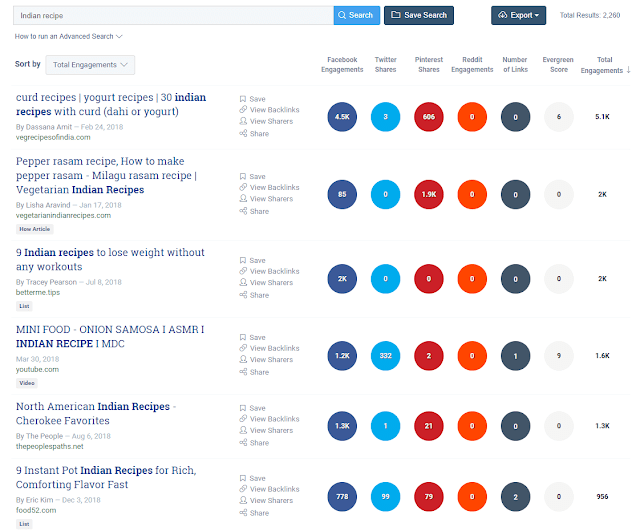
Create similar posts — but better, more intensive, and more helpful.
Have an editorial calendar of at least up to 3 months. And focus primarily on the pillar content.
Also Read: What is Pillar Content (And How it can Boost your Blog Traffic)
Some common blogging tips
Here are a few common blogging tips that will help you attract more traffic and drive higher engagement:
- Don’t focus on the length of the post. Focus on providing real value to the readers.
- Maintain a conversational tone.
- Include long-tail, LSI keywords.
- Format it in (very) small paragraphs.
- Include images and videos for visual appeal.
- Use bold/italics/underline/text color carefully.
- Include a Call to Action (CTA) at the end.
- Don’t try to target “everyone”; keep the focus on the “exact” audience you’re writing this for.
- The headline is everything. Spend a lot of time coming up with a great headline. (Read: 9 Blog Headline Best Practices)
- Make sure your first 100 words are gripping enough.
Aside from these tips, keep your knowledge, creativity, and originality at the center when writing a blog post.
10. There’s no such thing as “perfect”
You can’t get it all perfectly right. It’s a simple fact.
Somewhere in the process of starting a blog, you will mess things up; you will be confused and make wrong decisions.
Maybe you will end up choosing the wrong web host. Maybe the theme you chose a month back now looks poor. Or maybe, you’re blogging in a way that your target audience does not prefer.
There could be a lot of maybes and mistakes.
And IT IS OKAY.
You will make mistakes
This is your first time. You’re just a beginner. Things are bound to go wrong. And as your blog progresses, you will encounter even more challenges. You can’t be perfect in every end. In fact, there’s no such thing as ‘perfect’ in the first place.
In one thing or another, you will always find room to improve. You will often go “shit, that’s wrong” or “I should’ve done it better”.
It’s okay. It is a natural part of the learning curve. It’s an opportunity to get better.
So, don’t expect everything to be perfect; accept that it won’t be right from the go.
In the absence of trying to achieve perfection, you will find making small decisions rather easy and quick.
Recommended Read: 21 Ways Bloggers Waste Their Time
11. Promote your blog
Blogging is 20 percent writing and 80 percent marketing.
There was a time when you would create high-quality content that will eventually become a superstar with the very least effort in marketing.
But no more that is the case, thanks to high competition.
Today, just putting out good blog posts isn’t sufficient. You need to promote it across different channels on a very regular basis.
How to do it?
Social media platforms are your go-to here. As soon as you have published the blog post, start promoting it on Facebook, Twitter, LinkedIn, and other channels. Schedule the posts (using tools like Hootsuite) for automated posting. As and when relevant, keep on promoting the blog content for weeks and months.
Next, get active on Quora. Find questions that are related to the blog post you have just published. And then answer them with the genuine intent of helping the readers.
Don’t just post the link there. If you have written an in-depth blog, you would find many opportunities to link it in your answer.
The most common way is, say if you have written on “10 benefits of Creatine”. You can answer the question with five benefits and then just go “If you want to know more benefits, please go here” and then link it.
Similarly, you can do the same thing on Reddit. But be very very careful on Reddit to not look like a spammer. The moderators there are quite strict and may even ban you.
Next, you can republish your blog posts on Medium and LinkedIn’s Pulse.
(BUT do it only after 3-4 weeks from the original publishing date; so that the post is well-indexed by search engines and that they know the original source of the content.)
PRO TIP: For B2B, original and unique content do better on LinkedIn’s Pulse as compared to republished blog posts.
You can also start outreach efforts for backlinks. Google the topic that you have written the blog post on and then go through the results on the first few pages.
Use Backlink Checker to see who has backlinked them. Email these backlinking websites saying that you have written an even better post and that linking to you would be more valuable to their readers.
Although a positive response is a bit rare (unless you have a good brand reputation, which you don’t in the early days), you never know who might agree to give you a backlink. So, it’s worth trying.
Also, check out A Complete List of Off-Page SEO Techniques for 2020.
12. Create content obsessively
Okay, those who throw “work smart and not hard” may not necessarily appreciate this. But here’s the biggest punch-line you would read in this entire post…
We’re living in a time when your online success depends on your capability to create as much high-quality highly-relevant content, in the quickest span, as you can.
You need to produce content obsessively. It’s essential.
Of course, you’ve got to “work smart”. But that’s not tradable to “work hard”.
Yes, you will see a handful of bloggers who create content very occasionally and still manage to earn big money. But that’s their distinct model and strategy. For the rest of the majority, today, that doesn’t work as well and assuredly.
So, if you’re looking to outdo the competitive market, content is no-doubt your ultimate gateway.
The more you’re creating valuable and sustainable content, the greener will be your organic metrics in the long-term game.
The more, the better
Now, this isn’t just about creating articles only for your self-hosted blog. You must also consistently create content for social media channels, Medium, Quora, YouTube, and more.
The equation is fair and simple: more (smart) content means more engagement. And when you’re engaging with your audience often and more meaningfully, your ROI is bound to go high. Period.
Recommended Read: How to Create Content Fast (Without Hurting Its Quality)
13. Monetize at the right time
Recheck point #10 – Things will never be “perfect”. This is also another way of saying that you will never be 100 percent ready to take your blog to the next level.
So, when it comes to monetizing, don’t wait up for the “right moment”. Because you will never find one.
Indeed, there are many bloggers who monetize their blog way too early. But it’s also surprising that there exist just as many bloggers who take forever. Don’t be either of the group.
When you should do it?
Here’s a simple calculation…
Identify your customer lifetime value (CLV), which is the net profit that a customer will bring to you for the entire lifetime of the relationship between the two.
Now, think about the money you want to make per month and annually.
With the CLV number, calculate how many customers you really need to reach this desired monthly or annual profit.
Go to your Analytics and see if you’re getting sufficient traffic to convert them into profit.
For instance, if you need 25 customers to make the desired monthly income, is your blog getting a consistent inflow of, say, 100 unique daily visitors?
If yes, it’s definitely the time to monetize your blog.
In reality, this calculation isn’t that “simple”. But then you don’t have to be very specific or definite. Just look at these numbers to know if you’re getting enough traffic, engagement, and CTA conversion to generate the income you’re aiming for.
If yes, deploy your blog money-making strategies almost immediately.
Understand that the more delay you do in monetizing your blog, the more demotivated you will get. Because as superficial as it may sound, it’s really true: money is the biggest motivator.
Also Read: 21 Ways To Make Money From Your Blog
Conclusion
These are the basic steps on how to start a blog in 2020.
Again, on the way, there will be a handful of other challenges. But don’t worry. They are part of the process.
If you really want to become a successful blogger, these aren’t the challenges that you should worry about. Instead, you should keep your eyes to your small and big goals.
Hustle. And hustle some more.
Making money from blog isn’t going to be easy. In fact, today, it’s more difficult than ever. But that’s no reason for you to not start. Thousands of bloggers are living the life of their dream. If you’re consistent in your hard work, you can be one of them. Period.
Recommended Read:
Good luck! 🙂
Follow Spell Out Marketing on INSTAGRAM for bite-size tips on Content Marketing and SEO. (Click to check it out)
